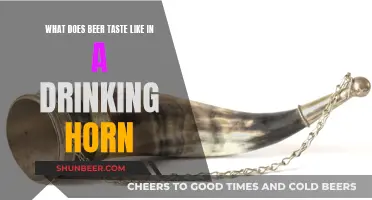
Beer has been brewed in England for thousands of years, and the country is known for its top-fermented cask beer, or real ale, which finishes maturing in the cellar of the pub and is served with only natural carbonation.
The most popular beer in England is Carling, followed by Fosters and Carlsburg. However, the popularity of a beer is rarely a testament to its quality. Cask ales, for example, are less popular than lager, but some are still doing very well. Sharp's Doombar is the most popular cask ale, with London Pride and a few Greene King beers close behind.
When it comes to craft beer, Punk IPA from Brewdog leads the way, but is still a long way behind the top cask ales.
In England, you'll find both regional and national beers. Carling, Fosters, and similar beers are nationally popular and can be found in almost any pub. Then there are slightly less popular beers such as Doombar, London Pride, and Brewdog, which are brewed in one location but can often be found all over the country.
England also showcases its smaller breweries, with thousands of local breweries across the UK. As of 2018, the UK had the most active breweries of any country in Europe, with over 2000.
When it comes to ordering a beer in an English pub, it's important to know what kind of pub you're in. City pubs, for example, attract people who work nearby and tend to be noisy and bustling, especially at lunch and right after work. Theme pubs are a subset of city pubs and include goth pubs, jazz pubs, and comedy pubs. Country pubs are often referred to as heritage pubs, and while they may look quaint from the outside, they might feature modern touches like a microwave menu of packaged burgers.
When it comes to ordering, it's important to be patient and not wave your money around to get the server's attention. Make eye contact, know what you want, and ask for it. Brits don't like a big foamy head on their beer, so don't be surprised if your glass is filled to the brim. If you want a cold beer, you'll have to order a lager, as other beers are served at cellar temperature.
| Characteristics | Values |
|---|---|
| Most popular beer in England | Carling |
| Second most popular beer in England | Fosters |
| Third most popular beer in England | Carlsborg |
| Most popular cask ale | Sharp's Doombar |
| Second most popular cask ale | London Pride |
| Most popular craft beer | Punk IPA from Brewdog |
| Number of breweries in the UK as of 2018 | Over 2000 |
What You'll Learn

English beer styles
Bitter
Bitter is a catch-all term for a family of ales that include ordinary bitters, strong bitters, best bitters, and extra special bitters. Despite the name, these beers are not particularly bitter, especially when compared to hop-heavy American IPAs. Bitter is a well-hopped pale ale, ranging in colour from pale gold to dark mahogany, and in strength from 3.5% to 7% ABV. Ordinary bitters are the weakest and the fairest in colour, ranging from gold to light copper. Best bitters are slightly stronger and feature a more pronounced maltiness and fruitiness. Strong bitters, also known as extra special bitters, have a heavier, more malty character and a more forward hops presence.
Mild
Mild ales are session beers with a familiar profile, featuring very little hop character. They come in pale and dark styles, with the latter being rich and deep brown to near-black in appearance. Mild ales are generally considered low-gravity beers with a low hop rate and a predominantly malty palate, ranging from 3% to 3.6% ABV. However, historically, mild ales were of standard strength for their time and were considerably stronger than modern versions.
Brown Ale
Brown ales are sweeter variations of English mild ales, ranging in colour from amber to dark brown. They feature more malt than hops, with fruity or nutty aromas and flavours, and ABV levels between 4% and 6%. Northern English brown ales tend to be drier and stronger than dark milds, with more alcohol and less sweetness.
Old Ale
Old ales are dark, malty beers above 4.5% ABV, also known as Winter Warmers. They are often aged for long periods in casks or vats, which promotes a tangy, acidic character and a sharp, sometimes fruity and vinous body. Lighter varieties have ABV levels between 4% and 7%, while darker versions are heavier and have ABV levels between 7% and 12%.
Porter
Porter is a dark beer that was first brewed in London in the 18th century. It is the ancestor of stout and is generally darker and more bitter than old ales, milds, and brown ales. Porter uses roast grains, which add bitterness and flavours of toast, biscuit, or coffee. Porter was the first beer to be aged at the brewery and dispatched ready to drink, allowing it to be produced on a large scale.
Stout
Stout is a stronger variant of porter, with a distinctive dark brown to jet-black colour. It has a roasted, toasty flavour that can be enhanced with notes of cocoa, coffee, or toffee. Stouts typically have ABV levels between 4% and 7% and are known for their complex flavour rather than high alcohol content. Variations of stout include oatmeal stout, oyster stout, sweet milk stout, and imperial stout.
India Pale Ale (IPA)
IPA is a well-hopped, lightly malted beer that was originally brewed to survive the long voyage to India. Modern English IPAs tend to be more malt-forward and less aggressive than their American counterparts, with a more earthy and floral hop profile. English IPAs typically have ABV levels between 4% and 7%.
Drinking Non-Alcoholic Beer: Safe to Drive?
You may want to see also

The rise of craft beer
The UK has witnessed a craft beer revolution in recent years, with a surge in the popularity of craft beer and breweries that are redefining the nation's beer culture. This movement has transformed the traditional landscape dominated by mass-produced lagers, making way for a diverse and innovative craft beer scene.
The roots of the craft beer movement in the UK can be traced back to the late 20th century when pioneering brewers sought to break away from the mainstream beer industry. Inspired by the American craft beer revolution, these brewers aimed to create unique, flavourful beers that celebrated quality ingredients and traditional brewing methods.
One of the defining features of the modern craft beer movement is the proliferation of small, independent breweries, often referred to as microbreweries, across the UK. These establishments prioritise quality over quantity, experimenting with a wide range of ingredients to produce distinctive and innovative brews. This shift towards localised and artisanal production has not only elevated the quality of beer but has also invigorated local economies and communities.
Craft brewers in the UK have embraced experimentation and innovation with ingredients and brewing techniques, leading to an explosion of diverse flavours and styles. From hop-forward India Pale Ales (IPAs) to rich and complex stouts, craft breweries are constantly pushing the boundaries of what beer can be. This diversity has captivated seasoned beer enthusiasts and attracted a new wave of consumers eager to explore unique and exciting taste experiences.
The rise of modern craft beer in the UK is closely tied to changing consumer preferences. As more individuals seek authenticity, flavour diversity, and a connection to the producers of their beverages, craft beer has become an appealing choice. Consumers are increasingly willing to explore different styles, support local businesses, and prioritise quality over quantity, aligning perfectly with the ethos of the craft beer movement.
The craft beer market is fast becoming an important force in the hospitality sector, driving growth and bringing a new wave of pubs and bars. The success of craft beer has also led to the emergence of specialist bottle shops, craft pubs with dozens of beers on tap, and retail services that help people discover craft breweries.
The passion for unique, flavourful, and locally crafted beers is here to stay, shaping the future of the UK's brewing landscape.
Beta Blockers and Beer: Is One Drink Safe?
You may want to see also

Beer drinking culture
Beer has been brewed in England for thousands of years, and the country is known for its top-fermented cask beer, or "real ale", which finishes maturing in the cellar of the pub and is served with only natural carbonation. English beer styles include bitter, mild, brown ale, old ale, stout, porter, and India pale ale. Lager increased in popularity from the mid-20th century, and today, lager remains the undisputed sales champion in Britain.
The English pub is a national institution, and going to the pub with friends or colleagues is an essential part of English beer culture. Pubs are entertainment centres and focal points of the community. Most pubs are owned and operated by breweries and sell mostly the beers they produce, along with a few guest taps. A "free house" is fully independent and sells any variety of beers. While the traditional pub is iconic in English life, pub chains such as Wetherspoons are taking over former shops and bank branches, offering a wide range of beers at a good price.
In England, beer is usually served at cellar temperature (between 10–14 °C), and English drinkers say that it relies on subtler flavours than beers from other nations, which are brought out by serving it at this temperature.
Beer drinking in England has changed over time and varies by region. For example, consumption levels in Scotland are consistently higher than in England, and the North East, North West, and South West have higher levels of consumption than London and the South East.
Binge drinking is well-established in England, and the country consistently ranks highest for binge-drinking culture in health reports. Binge drinking costs the UK economy approximately £20 billion a year, with 17 million working days lost to hangovers and drink-related illness.
The Campaign for Real Ale (CAMRA) was founded in 1971 to protect traditional, unpressurised beer and brewing methods.
Popular English beers include:
- Fuller's London Pride
- Morland's Old Speckled Hen
- Citra, by Oakham Ales
- Newcastle Brown Ale
- Jaipur, by Thornbridge
- Harvey's Sussex Best
- Fuller's London Porter
- Hobgoblin, by Wychwood
- King Goblin, by Wychwood
- Golden Glory, by Hall & Woodhouse
Hydration Station: Water and Beer's Uneasy Truce
You may want to see also

Beer serving etiquette
Ordering a Beer
When ordering a beer in a British pub, it is important to remember that there is no table service. You will need to go to the bar to place your order. If you are part of a group, it is customary to buy drinks in a "round", where each person takes turns to buy drinks for the whole group. It is also expected that you will have a drink that is roughly the same price as the others in your group. If you are drinking beer, you will usually be served a pint (568ml) unless you specifically ask for a half-pint. When ordering a draught beer, you will be brought a pint unless you specify otherwise.
Choosing a Beer
When choosing a beer, remember that "beer" is an umbrella term that can include lagers (light beer), ales (dark beer), bitters (light ale), stouts (very dark beer), pale ales, IPAs, and wheat beers. If you are looking for something local, see what the pub regulars are drinking—it is usually a local ale, cider, or perry (a pear cider). You can also ask to try a couple of "tasters" before you choose.
Paying for Drinks
When paying for your drinks, use contactless card if possible, but always carry cash as backup. It is not customary to tip in British pubs, but if you would like to, you can say "and one for yourself" to buy the bartender a drink, or leave some change in the tip jar.
Drinking Your Beer
In British pubs, beer is usually served at cellar temperature (between 10-14°C), which is often controlled by the pub. Lager, a pale beer usually carbonated and served refrigerated, is what beer is like in most of the rest of the world. If you would like your beer colder, order a lager.
The Perfect Pour
When pouring your beer, tilt your glass at a 45-degree angle and control the flow by starting with a slow pour and gradually increasing the speed. This will help create an even release of CO2, resulting in the right amount of foam while maintaining the flavor profile.
Beer and Tramadol: A Safe Mix?
You may want to see also

Beer history
Beer has been brewed in England for thousands of years, and it is known for its top-fermented cask beer, or "real ale", which finishes maturing in the cellar of the pub. Beer was likely already well-established in England when the Romans arrived in 54 BC, and it was certainly continued under them. In the 1980s, archaeologists found evidence that Rome's soldiers in Britain drank Celtic ale, and the first named brewer in British history, Atrectus the brewer, was recorded as supplying the garrison at Vindolanda.
In the Middle Ages, beer was one of the most common drinks and was consumed daily by all social classes in northern and eastern Europe, where grape cultivation was difficult or impossible. In England, per capita consumption was 275-300 litres a year by the Late Middle Ages, and beer was drunk with every meal. Alewives would put out an "ale-wand" to show when their beer was ready, and men gradually became involved in brewing, organising themselves into guilds such as the Brewers Guild in London.
In the 1400s, the use of hops in beer became more common, and beer with hops was known as "beer", while "ale" was unhopped. The first record of hopped beer in England was in 1412, made by a German alewife in Colchester. Hops were planted in Kent around 1520, and gradually hopped beer became dominant, though it is unclear when this happened.
In the 1700s, a popular new style of dark beer called "porter" was developed in London. It was the first beer to be aged at the brewery and dispatched ready to drink. The large London porter breweries pioneered many technological advances. Around the same time, India Pale Ale was developed, heavily hopped to survive the long journey to South Asia, marking the beginning of a global beer trade.
In the 1800s, the Beerhouse Act enabled anyone to brew and sell beer, leading to the opening of hundreds of new pubs throughout England and reducing the influence of large breweries. Demand for India Pale Ale (IPA) developed in England around 1840, and it became a popular product.
In the 1900s, the temperance movement and World War I emergency measures brought about changes such as higher taxation on beer, lower strengths, and restricted opening hours.
In the 1950s, pale ale had replaced mild as the beer of choice for most drinkers, and lager began to rise in popularity.
In the 1970s, the Campaign for Real Ale (CAMRA) was founded to protect unpressurised beer, and to differentiate between beer served from the cask and beer served under pressure.
Since the 2000s, there has been an "explosion" of interest in craft beer, with a focus on highly flavourful and distinctive beers from small breweries.
Drinking Beer Outside: Legal or Not?
You may want to see also
Frequently asked questions
The most popular beers in England include Carling, Fosters, Carlsburg, Stella Artois, Guinness, and Kronenbourg.
Beer styles in England include bitter, mild, brown ale, old ale, stout, porter, and India pale ale.
Cask ale is unfiltered and unpasteurized, giving it a limited shelf life. It is served at cellar temperature (between 10–14 °C), which is often controlled in a modern-day pub. Lager, on the other hand, is bottom-fermented beer and is usually served cold.
Pubs are entertainment centers and focal points of the community, whereas bars are less likely to be free-standing and more likely to be urban in setting and modern in style.







